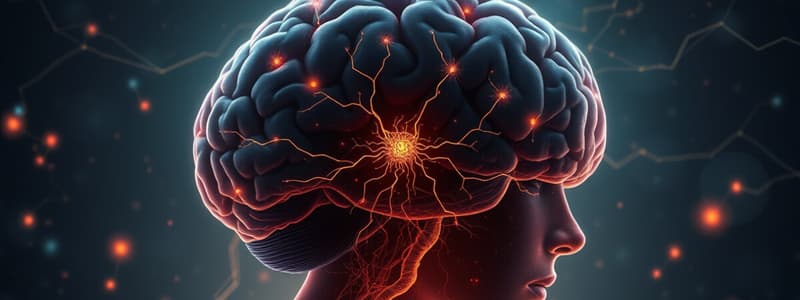Podcast
Questions and Answers
Which genetic characteristic is most commonly associated with Spinocerebellar Ataxia?
Which genetic characteristic is most commonly associated with Spinocerebellar Ataxia?
- Autosomal dominant inheritance (correct)
- Autosomal recessive inheritance
- X-linked inheritance
- Polygenic inheritance
What symptom is specifically defined as the inability to control the distance of movements in Spinocerebellar Ataxia?
What symptom is specifically defined as the inability to control the distance of movements in Spinocerebellar Ataxia?
- Ataxia
- Dysarthria
- Proprioception loss
- Dysmetria (correct)
What is a common method used for diagnosing Spinocerebellar Ataxia?
What is a common method used for diagnosing Spinocerebellar Ataxia?
- Electroencephalogram (EEG)
- Blood tests for metabolic disorders
- Genetic testing for specific mutations (correct)
- Lung function tests
Which treatment is typically NOT part of the management plan for Spinocerebellar Ataxia?
Which treatment is typically NOT part of the management plan for Spinocerebellar Ataxia?
Which statement about the prognosis of Spinocerebellar Ataxia is true?
Which statement about the prognosis of Spinocerebellar Ataxia is true?
What type of genetic inheritance pattern is primarily associated with Spinocerebellar Ataxia?
What type of genetic inheritance pattern is primarily associated with Spinocerebellar Ataxia?
Which genetic mutation is common to SCA1, SCA2, SCA3, SCA6, SCA7, and SCA17?
Which genetic mutation is common to SCA1, SCA2, SCA3, SCA6, SCA7, and SCA17?
What is the primary consequence of CAG repeat expansions in proteins associated with Spinocerebellar Ataxia?
What is the primary consequence of CAG repeat expansions in proteins associated with Spinocerebellar Ataxia?
How does the number of CAG repeats relate to the symptoms of Spinocerebellar Ataxia?
How does the number of CAG repeats relate to the symptoms of Spinocerebellar Ataxia?
What role does genetic testing play in the context of Spinocerebellar Ataxia?
What role does genetic testing play in the context of Spinocerebellar Ataxia?
Flashcards are hidden until you start studying
Study Notes
Spinocerebellar Ataxia (SCA)
-
Definition: A group of inherited disorders characterized by progressive dysfunction of the cerebellum and spinal cord, leading to problems with coordination and movement.
-
Types:
- Over 40 different types recognized (e.g., SCA1, SCA2, SCA3, etc.)
- Types are classified based on genetic causes and clinical features.
-
Genetics:
- Most types are autosomal dominant.
- Caused by expansions of CAG (glutamine) repeat sequences in specific genes.
- Repeat length often correlates with age of onset and severity.
-
Symptoms:
- Ataxia (loss of coordination)
- Dysmetria (inability to control the distance of movements)
- Tremors
- Gait abnormalities
- Speech difficulties (dysarthria)
- Loss of proprioception (awareness of body position)
-
Onset:
- Varies widely depending on the type (childhood to adulthood).
- Early-onset types tend to have more severe symptoms.
-
Diagnosis:
- Clinical evaluation of symptoms.
- Genetic testing to identify specific mutations.
- Imaging studies (e.g., MRI) to assess cerebellar atrophy.
-
Management:
- No cure currently available.
- Symptomatic treatment includes:
- Physical therapy to improve balance and coordination.
- Occupational therapy for daily living activities.
- Speech therapy for communication issues.
-
Prognosis:
- Progression and life expectancy vary by type.
- Many individuals experience significant disability over time.
-
Research:
- Ongoing studies focus on understanding disease mechanisms.
- Investigations into potential treatments, including gene therapy and neuroprotective strategies.
Definition
- Inherited disorders affecting the cerebellum and spinal cord, causing coordination and movement issues.
Types
- More than 40 recognized types, such as SCA1, SCA2, and SCA3.
- Classification based on genetic causes and clinical characteristics.
Genetics
- Most types follow an autosomal dominant inheritance pattern.
- Caused by CAG (glutamine) repeat expansions in specific genes.
- Length of CAG repeats is linked to age of onset and disease severity.
Symptoms
- Ataxia: Loss of coordination impacting movement.
- Dysmetria: Difficulty in controlling the distance of movements.
- Tremors: Involuntary shaking of limbs or body parts.
- Gait abnormalities: Issues with walking stability and patterns.
- Dysarthria: Speech difficulties arising from motor control issues.
- Loss of proprioception: Reduced awareness of body positioning.
Onset
- Age at onset varies significantly among different types, spanning from childhood to adulthood.
- Early-onset types are associated with more severe symptomatology.
Diagnosis
- Involves clinical evaluation assessing motor functions and coordination.
- Genetic testing identifies specific mutations related to various SCA types.
- Imaging studies, such as MRI, are used to detect cerebellar atrophy.
Management
- No cure is available, focusing on symptomatic treatment.
- Physical therapy is employed to enhance balance and coordination.
- Occupational therapy supports daily living activities affected by symptoms.
- Speech therapy addresses communication difficulties resulting from dysarthria.
Prognosis
- Disease progression and life expectancy vary by SCA type.
- Many individuals may experience significant disability as the disorder advances.
Research
- Active research aims to clarify disease mechanisms and progression.
- Investigations are ongoing for potential treatments, including gene therapy and neuroprotective approaches.
Spinocerebellar Ataxia (SCA) Overview
- Spinocerebellar Ataxia (SCA) encompasses a group of hereditary disorders linked to progressive ataxia caused by cerebellar degeneration.
- SCAs arise from genetic mutations, which can follow autosomal dominant or autosomal recessive inheritance patterns.
Common Genetic Mutations
- SCA1:
- Gene involved: ATXN1
- Characterized by CAG repeat expansion.
- SCA2:
- Gene involved: ATXN2
- Also features CAG repeat expansion.
- SCA3 (Machado-Joseph disease):
- Gene involved: ATXN3
- Involves CAG repeat expansion.
- SCA6:
- Gene involved: CACNA1A
- CAG repeat expansion is a distinct feature.
- SCA7:
- Gene involved: ATXN7
- Presents with CAG repeat expansion.
- SCA12:
- Gene involved: PPP2R2B
- Contains CAG repeat expansion.
- SCA17:
- Gene involved: TBP
- Characterized by CAG repeat expansion.
Mechanism of Mutations
- CAG repeat expansions lead to abnormal proteins with long polyglutamine (polyQ) tracts.
- Misfolded and aggregated proteins result in cellular toxicity, contributing to neurodegeneration.
Variability in Disease Presentation
- The extent of CAG repeats correlates with age at onset and severity of symptoms.
- Increased CAG repeats generally correspond to earlier onset and exacerbated ataxic symptoms.
Genetic Testing Importance
- Genetic testing is crucial for confirming specific SCAs by detecting mutations, guiding accurate diagnosis.
- Helps in family planning and provides insights into prognosis.
Research and Therapeutic Implications
- Current research focuses on gene therapy and potential treatments aimed at alleviating the harmful effects of genetic mutations.
- Understanding these genetic factors is essential for improving diagnosis, management, and treatment strategies.
Studying That Suits You
Use AI to generate personalized quizzes and flashcards to suit your learning preferences.




